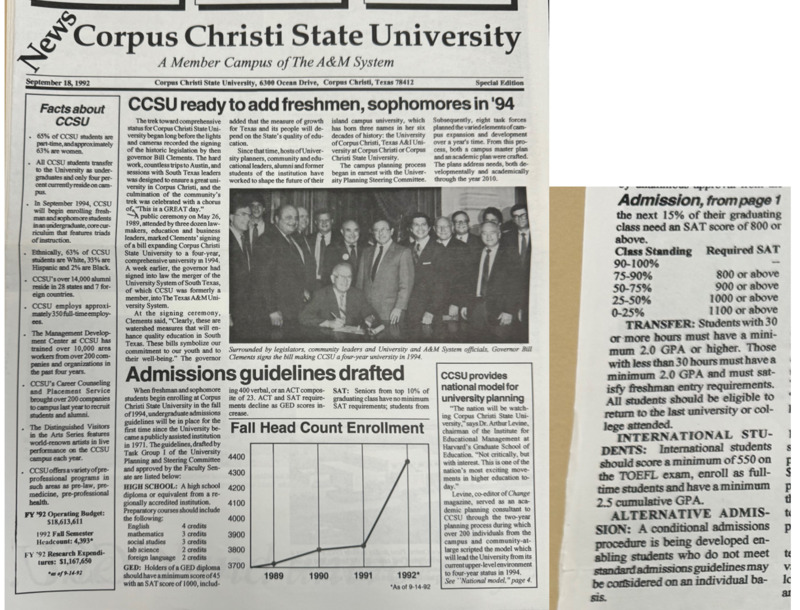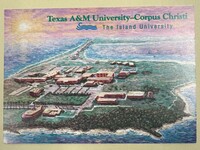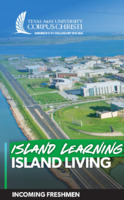Recruiting TAMU-CC's First Freshman Class (1994)
Presented by: Rene Zamora
What did it take to recruit the first freshman class at TAMU-CC?
A major historical moment occurred in the fall of 1994, when the first freshman class attended classes at Texas A&M University-Corpus Christi (TAMU-CC). Looking back to this historic moment, we can see how it has impacted our larger community and what implications it has our on current day practice.
As the director of undergraduate admissions at TAMU-CC, I have the privilege of leading the freshman recruitment team. This project has given me an opportunity to discover how TAMU-CC transitioned to a four-year institution and the work that was done to recruit and enroll the first freshman class. Additionally, as an alumnus of the university, that first attended TAMU-CC in 2010, just 16 years after the first-freshman class enrolled, I have a new passion to assist in preserving and showcasing the work that it took to usher in the first freshmen class to our beloved university.
University artifacts were retrieved from the Mary and Jeff Bell Library’s Special Collections and Archives to answer the research question above; all artifacts were from years 1992 and 1994 as I thought that this would be an appropriate time for the institution to begin planning how they would recruit this new class. Additionally, I interviewed Mrs. Margaret Dechant who served as Director of Admissions during that time.
This digital exhibit is intended for anyone (researcher, scholar-practitioner, student, community member) that is interested in learning about the work that took place to bring in the first freshman class. I encourage this digital exhibition to be a starting point for future investigations into this historic moment.
CLICK HERE to access the digital archives that were collected from the Mary and Jeff Bell Library and to hear the interview that was conducted.
Brief History
One of the most important artifacts that was located during the history harvest was from the Corpus Christi State University (CCSU) Newspaper. The CCSU News was published by the public information office to share university updates with the campus community. The special edition of the newspaper was published on September 18, 1992 and included stories that kick started my dive into answering the guiding research question.
First, the newspaper highlights the legislation signed by Governor Bill Clements that expanded the University of Corpus Christi to a four-year institution. It also touches on information that can be researched further such as the merger of the University of South Texas System into the Texas A&M University System and the hard work that South Texas leaders did to ensure the university could transition to becoming a four-year comprehensive institution.
Next, the newspaper shares the admission guidelines that were drafted for domestic and international high school students, GED holders, and transfer students. The next year, the admission requirements were also included in the 1994-1995 university catalog.
The interview with Margaret Dechant should also be highlighted as she was the one who wrote the verbiage for the catalog and, in my opinion, was a key leader in ushering the first freshman class.
Some key takeaways from the interview include:
- While the admissions process as being drafted, the Texas legislature required the university to draft competitive admission standards and to recruit, enroll, and retain students that had historically underrepresented in higher education.
- Recruitment efforts focused on “our backyard” and within 150 mile radius of Corpus Christi. When opportunities were presented to recruit further than that, they did.
- The legislature capped the first freshman class at 400; 404 enrolled. At the time, they did not have historical data to refer to, so it was a challenge to determine how many students to admit to secure the enrollment.
- Margaret mentioned that above all, it is important to recognize who we are as an institution and we should focus on being servant leaders to provide access to higher education to those that may not have the necessary information needed to enroll in college (example: first-generation students).
Relevency to Today's Work and Implications
As stated by Morphew and Harley (2006), university missions can help the organization’s members understand their imperatives and give them a shared sense of purpose to motivate and inspire the members to communicate the characteristics, values, and history of the organization to their key constituents. TAMU-CC’s current mission statement is below.
Texas A&M University-Corpus Christi is a premier institution of higher education, dedicated to providing an unparalleled commitment to student success, developing professionals and engaged leaders, closing achievement gaps as a Hispanic and Minority Serving Institution, and providing intellectual capital through research, creative activity, and innovation for South Texas, the Gulf of Mexico, and beyond.
Morphew and Harley (2006) also share that mission statements can be seen as “stock phrases” that are vague or may be unrealistic ambition. Does our mission statement guide decision making and priorities? Are we doing enough? These are questions that future researchers may be interested in researching.
TAMU-CC has also outlined The Islander Impact: Strategic Plan 2030, which includes core values. The “Community & Belonging” value indicates that TAMU-CC will recruit and retain students, faculty, and staff from diverse backgrounds and provide a university culture that is sensitive and responsive to underserved and underrepresented groups in higher education.
Orphan and McClure (2022) share that regional public universities (RPU) contribute to their communities and can be considered anchor institutions that provide infrastructure for their community. They also share that many were founded to help provide access to students that may traditionally been excluded from post-secondary education such as students of color, low-income students, first-generation students, women, and working adults. RPUs have become more accessible and align their strategic planning efforts with their commitment to be accessible.
TAMU-CC has continued to provide opportunities for students to access higher education by adding various degree programs, having regionally based recruiters, and by providing admission standards and programs that give students access to earn a degree. Orphan and McClure (2022) also indicate that RPUs make efforts to be student-centered and provide regional service.
The Expansion to a Four-Year University
In 1989, when the University of Corpus Christi joined the Texas A&M System, the South Texas Border Initiative (STBI) was approved which also allowed for people to gain more access to higher education. The STBI allowed for funding to allow insitutions to offer graduate degrees, increase funding for institutions, and more.
Joining the Texas A&M System and the passing of the STBI were a catalyst to ensuring that students in Coastal Bend had additional opportunities and resources to access higher education.
1990's recruitment postcard vs 2023 recruitment brochure.




